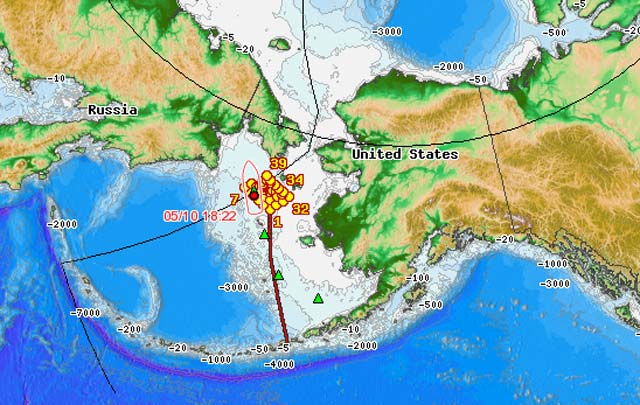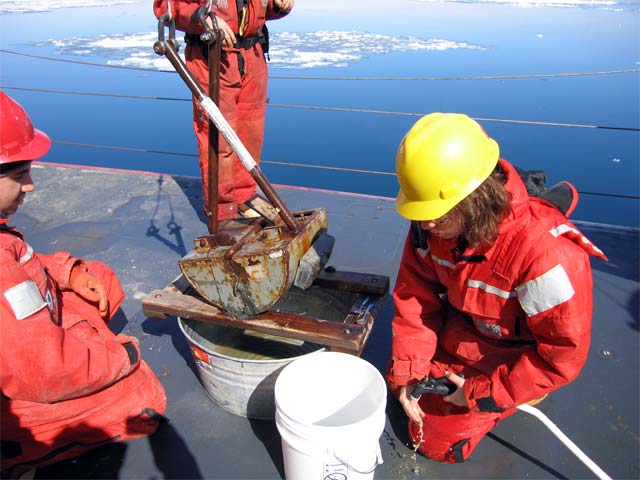( Log In ) Log In is for TREC Teachers & Researchers only
  |
| Samantha_Dassler_Barlow |
 May 12 2006, 12:45 AM May 12 2006, 12:45 AM
Post
#1
|
 Advanced Member    Group: TREC Team Posts: 99 Joined: 12-April 06 Member No.: 23 |
Date: May 10, 2006
GPS Coordinates Latitude: 61° 56’ N Longitude: 174° 40’ W  Current Location at the time of this journal. Jackie changed my shift to a day shift from 0800 to 1000 (that’s 8 am to 8 pm). Yea! Even though I slept during the day yesterday, I still went back to bed last night and fell asleep with no problem. It seems easier to go right back to normal than it does to try to adjust to a completely opposite schedule. So far, I really like this new day shift because I get to see more of Patty. She and I help each other work out the troubles with our computers and sending our photos and journals. Many of you probably do not realize that we are sending our journal entries in bits and pieces. Because of the size limit on email, we can only send one Word document or one picture at a time. A journal entry with text and 4 images gets sent to our web person, Ben, as five separate emails. Then, the Almighty Ben, Zen Master of the Web, assembles them and uploads them onto our website. I started out in the lab this afternoon when we came on to the next station after lunch. We are spending around 3.5 to 4 hours on each station. It takes that long to move through each step of the sampling process. Then it takes about an hour to get to the next station. So what is the sampling process? Here is the simple version of the sequence of sampling that happens at each station. Below, you will find a small explanation of each step. I will go into more detail about each step as I spend time with all the different scientists. From fantail of boat • CTD for water profile • Zooplankton net • 7 vanVeen grabs for critters and sediment • HAPS core – for sediment cores from the seafloor • Otter trawl – for critters on the surface and just above the surface Independent of work on back of boat, but continuous during the day • Light meter – to measure UV radiation and photosynthetic radiation • Methane analyzer – to measure methane in the atmosphere • Bird observations – from the bridge and by helicopter • Marine mammal observations – bridge • Ice surveys – bridge • Multi-beam images – to map the seafloor First the CTD goes in the water. That stands for “Conductivity – Temperature – Depth.” It is a “rosette” of canisters that close at different depths when it is lowered into the water. Then, when it comes up, everybody scrambles to take the water samples out of it immediately. This is the instrument I told you about yesterday. All the scientists are measuring something different in those water samples and they all want the water from the CTD canisters, but they have to share. There are other things the scientists are looking for in the water too. Some are trying to find the concentration of chlorophyll, which would indicate how much algae or phytoplankton is in the water. Another is looking at UV penetration, how far the harmful rays of the sun are reaching in the water.  This is the CTD (Conductivity – Temperature – Depth). All the scientists have to share the water samples that it collects at different depths. The CTD allows the scientists to get a better vertical profile of the properties of the water from the surface to the bottom. Next comes the zooplankton net. Some of the scientists are looking to see what species of zooplankton are living in the Bering Sea. The “zoo-“ means animal, and the “-plankton” means floating. These microscopic, floating animals are a large part of the food web.  Zooplankton Net After the zooplankton net, they start the vanVeen grabs. This machine is lowered to the seafloor. It grabs a huge chunk of the mud and then brings it to the surface. They do this seven times. A few of the scientists are interested in the sediment and the microscopic creatures that live in or stick to the sediment. Another is interested in the “macro fauna,” the bigger animals that live in the mud or on the surface of the mud. Why is it important that the CTD goes in first? I’ll give you a hint: it has to do with the subject in this paragraph.  A vanVeen Grab The HAPS core comes next. HAPS is a Danish acronym that describes what it looks like and does. It is an instrument that is sent to the bottom and it plunges a cylinder into the seafloor and brings a core back up to the surface. There are scientists that are interested in studying the layers of diatoms that are found in the sediment. They are also measuring the oxygen levels in the water that gets trapped in the cylinder above the sediment. My scientist, Lee, says that it is an indicator of recent sedimentation. The otter trawl is the last thing they do at a station. No, it is not for otters. That is just its name. They drag a net on the seafloor surface and in the water just a little above the seafloor to catch all the critters that live down there. I’ll tell you more about those tomorrow in the “Critters” journal. There are other kinds of research that go on besides all this sampling from the fantail of the boat. There is a light meter, an atmospheric methane analyzer, bird observations from the boat and from a helicopter, marine mammal observations, ice surveys, and seafloor imaging that are all happening simultaneously and independent of what happens on the back of the boat. That’s the basic routine of a shift whenever we come to a new station. It will take the whole month to get through all of the stations, one after another, to collect the data. The sampling goes on, all night and all day long. By the way, people are still coming up to me and reminding me to check my spelling. |
| admin |
 May 12 2006, 12:52 AM May 12 2006, 12:52 AM
Post
#2
|
|
Administrator    Group: Admin Posts: 35 Joined: 14-April 05 Member No.: 1 |
Many of you probably do not realize that we are sending our journal entries in bits and pieces. Because of the size limit on email, we can only send one Word document or one picture at a time. A journal entry with text and 4 images gets sent to our web person, Ben, as five separate emails. Then, the Almighty Ben, Zen Master of the Web, assembles them and uploads them onto our website. I think you misspelled "Almighty Ben." It's actually C-Y-B-E-R M-U-L-E. Nevermind, I've seen it both ways. |
  |
2 User(s) are reading this topic (2 Guests and 0 Anonymous Users)
0 Members:

|
NSF Acknowledgment & Disclaimer | Time is now: 19th November 2024 - 08:28 AM |
Invision Power Board
v2.1.7 © 2024 IPS, Inc.









